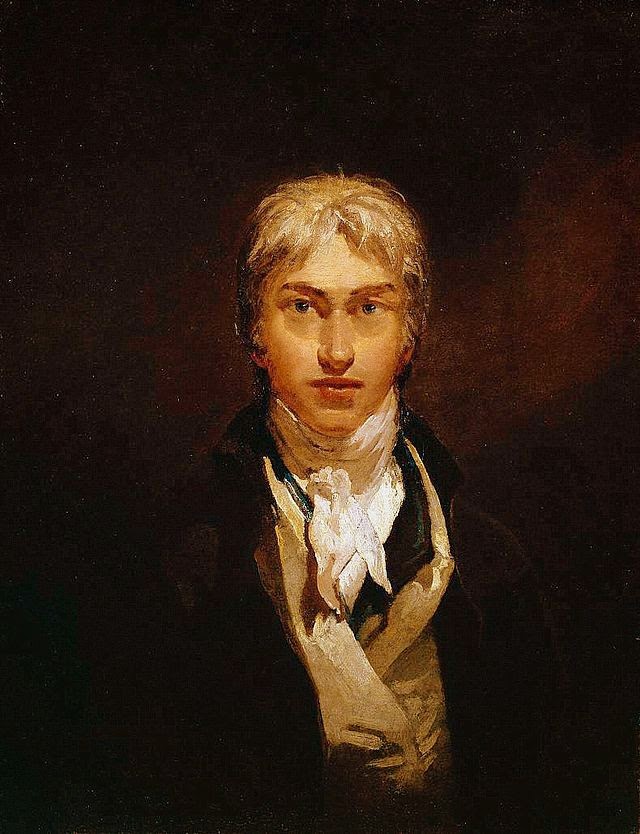or
"I Saw a Rohmer film once. It Was Kinda Like Watching Paint Dry"**
Mike Leigh's new film Mr. Turner is a 2 1/2 hour exploration of the habits, work and otherwise, of painter William J.M. Turner (portrayed by Timothy Spall), who was a catalyst for the transition from romantic realism to impressionism, work that suggested a subject while not imposing a strict technique to the work. The subjects were landscapes and reflected reality but did so in an unnatural way. Turner employed the most mixed of media—paint, water-colors and texturing from all sorts of sources, egg-whites, spit, dirt, grit, whatever it took to give substance to form, while satisfying the needs of patrons for an evocative scene to hang in the entryway that suggested the natural in man-made settings.
A man of unconventional technique would, naturally, have unconventional habits and Turner was everything but conventional. He could walk among the gentry and the hoi-polloi, putting up a good front of civility when comfortable. But, in private moments, he was a growling, harrumphing potato of a man, letting civility drop and being a very flawed human being.
It's always an issue making a movie about painters—at one time, you have to make the process of painting an interesting visual representation, evoking inspiration and artistry; at the same time there is the need to contrast the art and the life, creating drama that is lacking in the creative process.
Think about past flicks about painters—Lust for Life (Van Gogh), Moulin Rouge (Toulouse Lautrec), The Agony and the Ecstasy (Michelangelo), Pollock (mm-hmm), Girl with the Pearl Earring (Vermeer)—they succeed when they tell the story of a single work, and lose their way when trying to do a broad overview (except when psychosis is involved).
But psychosis is, at least, interesting. Self-possessed sloth is not. It is interesting to watch Spall wandering around seeking inspiration wherever he finds it—on the sea, in a brothel, in the street with Leigh trying to match the visual strategy (texture, color) with Turner's vision of the world. But, there isn't much of an arc of character in the film, merely in the public's perception of his work, which downgrades as its subject matter becomes more obscure and less tangible.
And less understandable. Not that Turner, the man, is any more penetrable, mostly unreadable, expressing himself with noncommittal grunts and growls. As Turner goes on his sorties, observing Nature, sketching the shape of things, experimenting with texture and color, we see the observation but not the process—we're never given the understanding, the interpretation, because Turner is so uncommunicative. We are privy to the inspiration and, once in awhile, the end result, but how it's gotten there remains a mystery.
Leigh seems to be aware of this, knows it's hopeless and illustrates the issue by putting in, as a major character, Turner's maid Hannah Danby (Dorothy Atkinson) who cleans, keeps inventory, cooks and provides the occasional sexual distraction; their relationship is one of mute complacency and compliance, and despite his name being the title, it is she you are left contemplating long after the movie ends. She is the only (other) character focused on throughout the entire movie. She is certainly the most sympathetic.
It draws me back to something writer John D. McDonald wrote to his correspondent, the comedian Dan Rowan (and documented in the book "A Friendship") about the latter's statement that he hated his soon-to-be-ex-wife; McDonald wrote "Love is not the opposite of hate; they're merely two sides to the same coin. The opposite of love is indifference."*** Turner is indifferent to just about everything except his appreciation for the artistic potential of Nature for subject matter, as well as the one warm relationship shown—to his father. Everything else is a manifestation of indifference, a limited focus of caring.
 |
| James Bond (Daniel Craig) contemplates Turner at The National Gallery from Skyfall. |
 |
| Mike Leigh's CGI recreation of that scene from Mr. Turner. |
 |
| Portrait of the Artist as a Young Man |
** From Night Moves (1975)
*** Elie Weisel used this observation in his 1986 Novel acceptance speech and is often credited with its creation. MacDonald wrote it to Rowan in 1971—the book was published in 1986.




.jpg)






No comments:
Post a Comment